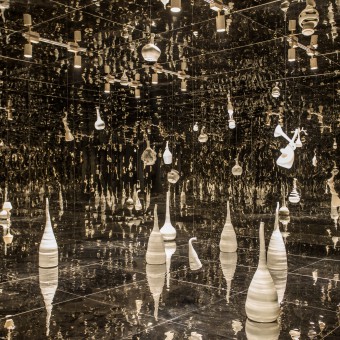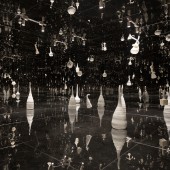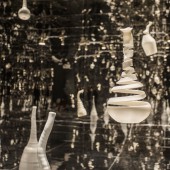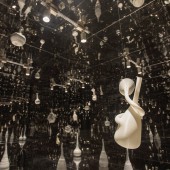
| THE AWARD |
| CATEGORIES |
| REGISTRATION |
| SUBMIT YOUR WORK |
| ENTRY INSTRUCTIONS |
| TERMS & CONDITIONS |
| PUBLICATIONS |
| DATES & FEES |
| METHODOLOGY |
| CONTACT |
| WINNERS |
| PRESS ROOM |
| GET INVOLVED |
| DESIGN PRIZE |
| DESIGN STORE |
| THE AWARD | JURY | CATEGORIES | REGISTRATION | PRESS | WINNERS | PUBLICATIONS | ENTRY INSTRUCTIONS |
Ceramics Extension Art Installation by Tairan Hao |
Home > Winners > Design #104079 >Interview |
 |
|
FS: What is the main principle, idea and inspiration behind your design?
TH: The relationship between the virtual world and the real world generates the form of this installation design and the traditional method of crafting versus what can be crafted with contemporary technologies. The development of civilization proceeds as time goes on. Therefore, the mirror reflection in the installation's interior space shows the infinite possibility of what time can change. Technology allows humans to define what is real and what is virtual and all the connections.
FS: What has been your main focus in designing this work? Especially what did you want to achieve?
TH: I wanted to focus on giving a compelling feeling to the audience while I can express my idea in the right way.
FS: What are your future plans for this award winning design?
TH: Based on the concept of this design, I will try to expand my works and create new works that form an independent series.
FS: How long did it take you to design this particular concept?
TH: The project started in 2016 in Beijing and finished in 2017. It was exhibited in Beijing Today Art Museum in 2017.
FS: Why did you design this particular concept? Was this design commissioned or did you decide to pursuit an inspiration?
TH: The visual interaction generates a strong feeling to the audiences that every object, everyone, everything is being extended infinitely. With the presence of sculpture, it is communicating part of the objects they see are real, but the other objects are the reflection by the mirrors, which is unreal. The interaction makes people think that they are stepping into a fantasy world that is created by themselves.
FS: Is your design being produced or used by another company, or do you plan to sell or lease the production rights or do you intent to produce your work yourself?
TH: I am not planning to sell the work at this moment because the sculpture quantity is limited.
FS: What made you design this particular type of work?
TH: The interactive need from the audience. My intention was not to only let people see the outcome of my exploration, but also have an interactive and immersive feeling while they look at them.
FS: Who is the target customer for his design?
TH: The audience who went to the art exhibition.
FS: How did you come up with the name for this design? What does it mean?
TH: The name is directly expressing the concept of the work - ceramics extension: what can be expanded and explored based on the original characteristics of ceramics.
FS: Which design tools did you use when you were working on this project?
TH: 3D printing; Plastic; aluminum mirrors; porcelain, LED lights
FS: What is the most unique aspect of your design?
TH: When the audiences step into the installation space, they will sense a feeling of visual infinity. The visual interaction generates a strong feeling to the audiences that every object, everyone, everything is being extended infinitely. The interaction makes people think that they are stepping into a fantasy world that is created by themselves.
FS: Who did you collaborate with for this design? Did you work with people with technical / specialized skills?
TH: I collaborate with Shan, my partner, who initialized the idea that using mirrors as an element in the space design.
FS: What is the role of technology in this particular design?
TH: The installation is formed by traditional handmade ceramics sculptures and 3D printed plastic sculptures. There is a total of 130 pieces of sculptures in the installation space. The installation is designed to display in a space surrounded by reflected glass mirrors, with 5 LED lights that give the audience a fantasy and futuristic feeling. The installation design's meaning is to show the communication between the future and the past, modern technology and traditional handicraft, the real world, and the virtual world.
FS: Is your design influenced by data or analytical research in any way? What kind of research did you conduct for making this design?
TH: I did some research on the characteristic of traditional ceramics versus the characteristic of the modern technology 3D printer. My research outcome allowed me to produce the visual effect of my 3D printed sculptures.
FS: What did you learn or how did you improve yourself during the designing of this work?
TH: The arrangement of the sculptures was one of the challenges in the design process. Some of the ceramics were too heavy to use ropes to hold and connect with the roof. Therefore, most of the sculptures are remade and reprinted by the 3D printer, using lighter materials then sprayed by the glazed-look white color to the surface.
FS: Thank you for providing us with this opportunity to interview you.
A' Design Award and Competitions grants rights to press members and bloggers to use parts of this interview. This interview is provided as it is; DesignPRWire and A' Design Award and Competitions cannot be held responsible for the answers given by participating designers.
| SOCIAL |
| + Add to Likes / Favorites | Send to My Email | Comment | View Press-Release | Translations |





